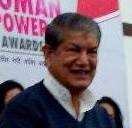Harish Rawat
| Harish Rawat | |
|---|---|
| हरीश रावत | |
 | |
| 7th Chief Minister of Uttarakhand | |
|
Assumed office 11 May 2016 | |
| Governor |
Aziz Qureshi Krishan Kant Paul |
| Preceded by | President's Rule |
|
In office 1 February 2014 – 27 March 2016 | |
| Preceded by | Vijay Bahuguna |
| Succeeded by | President's Rule |
| Union Minister of Water Resources | |
|
In office 30 October 2012 – 31 January 2014 | |
| Preceded by | Pawan Kumar Bansal |
| Succeeded by | Uma Bharti |
| Member of Parliament for Haridwar | |
|
In office May 2009 – May 2014 | |
| Preceded by | Rajendra Kumar Badi |
| Succeeded by | Ramesh Pokhriyal |
| Member of Rajya Sabha | |
|
In office 2002–2008 | |
| Constituency | Uttarakhand |
| Member of the 7th, 8th and 9th Lok Sabhas for Almora | |
|
In office 1980-91 | |
| Preceded by | Murli Manohar Joshi |
| Succeeded by | Jeewan Sharma |
| Personal details | |
| Born |
27 April 1948 Mohanari, Almora, United Provinces, India (now in Uttarakhand) |
| Political party | Indian National Congress |
| Alma mater | University of Lucknow |
| Religion | Hinduism |
Harish Chandra Singh Rawat (born 27 April 1948) is an Indian politician who has been Chief Minister of Uttarakhand since 2016. Previously he served as Chief Minister from 2014 to 2016. A five-time Member of Parliament, Rawat is a leader of the Indian National Congress party. As a member of 15th Lok Sabha, Rawat served as Union Minister of Water Resources in the cabinet of Prime Minister Manmohan Singh from 2012 to 2014.[1] He also worked as Minister of State at the Ministry of Parliamentary Affairs, Ministry of Agriculture, Ministry of Food Processing Industries[2] (2011-2012) and Ministry of Labour and Employment[3] (2009-2011).
Early life and education
Harish Rawat was born in Mohanari village, near Chaunalia in Almora district of the United Provinces (now Uttarakhand) on 27 April 1948 in a Rajput family[4] to Rajendra Singh Rawat and Devki Devi. He received a Bachelor of Arts and LL.B. from Lucknow University.[5]
Early political career
Starting at village level politics, and after staying as a trade unionist and an Indian Youth Congress member for many years, he joined the Indian Parliament in 1980 as a member of the 7th Lok Sabha by defeating the BJP veteran Murli Manohar Joshi from Almora parliamentary constituency, followed by the 8th Lok Sabha and the 9th Lok Sabha. He has been head of Congress Volunteer Wing, Congress Seva Dal, since 1980.
Later years
In 2000, he was unanimously elected as President of Uttarakhand Pradesh Congress Committee (UPCC),[6] and remained so until he was replaced by Yashpal Arya. In 2002, he was elected as a member of the Rajya Sabha, the upper house of Indian parliament.
In the 2009 general election, he left his traditional stronghold of Almora after it became a reserved seat post delimitation to contest from Haridwar, and won the election with over 3.3 Lakh of votes.[7]
Chief Minister of Uttarakhand
In February 2014, Rawat took the oath of office as Chief Minister of Uttarakhand when Vijay Bahuguna resigned due to criticism of his handling of rehabilitation after June 2013 floods.[8] In July 2014, he won a by-election from Dharchula assembly seat by over 19,000 votes.[9]
On 18 March 2016, nine Congress MLAs rebelled against Rawat, reducing the Congress-led Government to a minority. The Union Government decided to impose President's Rule in the state, and the order was signed by President Pranab Mukherjee on 27 March 2016.[10]
References
- ↑ "Harish Rawat Rawat takes Charge as Union Minister of Water Resources". Press Information Bureau.
- ↑ "Union Council of Ministers". The Hindu.
- ↑ "Ministers and their portfolios". NDTV.
- ↑ TOI
- ↑ Detailed Profile: Shri Harish Rawat National Portal of India
- ↑ Harish Rawat elected Uttaranchal PCC chief The Hindu, 4 December 2000.
- ↑ Haridwar CNN IBN.
- ↑ http://thehindu.com/news/national/other-states/uttarakhand-chief-minister-vijay-bahuguna-resigns/article5638527.ece
- ↑ "Uttarakhand CM Harish Rawat wins Dharchula's Assembly seat". The Economic Times. 9 August 2014. Retrieved 27 July 2014.
- ↑ "Sting operation on Harish Rawat sea fate in Uttarakhand". hindustantimes.com. Hindustan Times. Retrieved 28 March 2016.
12. उत्तराखंड के मुख्यमंत्री ने प्रवासियों से कहा - घर लौट आओ प्लीज http://www.uttarakhandnews.org/2015/02/uttarakhandchiefministerharishrawat_4.html
External links
| Lok Sabha | ||
|---|---|---|
| Preceded by Murli Manohar Joshi |
Member of Parliament for Almora 1980 – 1991 |
Succeeded by Jeewan Sharma |
| Preceded by Rajendra Kumar Badi |
Member of Parliament for Haridwar 2009 – 2014 |
Succeeded by Ramesh Pokhriyal |
| Political offices | ||
| Preceded by Pawan Kumar Bansal |
Union Minister of Water Resources 2012 – 2014 |
Succeeded by Uma Bharti |
| Preceded by Vijay Bahuguna |
Chief Minister of Uttarakhand 21 February 2014 – 27 March 2016 |
Succeeded by President's Rule |
| Wikimedia Commons has media related to Harish Rawat. |